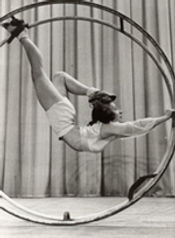
Rhon Wheel
The Rhon wheel was invented in 1925 by Otto Feick in Germany-that's why we also hear the name "German wheel." He filed a patent as a "wheel-gymnastic and sports tool." The patent was issued on November 8, 1925; the name "Rhönrad" has been registered and protected since 1926 (Rhön is the name of the mountain region where the wheel was invented).
Structure
The Rhön wheel consists of two parallel metal circles connected by crossbars. These circles vary in diameter depending on the height of the user, generally between 1.5 and 2.3 meters. The crossbars serve as gripping points for the acrobat's hands and feet.
Usage and Techniques
The wheel is used to perform a variety of gymnastic and acrobatic exercises, including:
Vertical Rotations: The athlete stands inside the wheel and rolls it forward or backward, performing full rotations.
Lateral Rotations: The wheel is rolled sideways, with the athlete performing wagon-wheel-like movements.
Jumps and Stunts: The athlete can perform jumps and other stunts while the wheel is in motion.
Rhön wheel performances can be spectacular, combining strength, balance and coordination.
Competitions and Disciplines
Rhön wheel is a recognized sports discipline with competitions at national and international levels. Competitions include various categories such as:
Straight Line: The athlete performs exercises in a straight line.
Spiral: The athlete performs spiral movements.
Vault: The athlete performs jumps and other complex stunts.
Physical Benefits
The use of the Rhön wheel offers numerous physical benefits, including:
-
Improved balance and coordination.
-
Increased muscle strength, particularly in the core muscles and extremities.
-
Development of flexibility and agility.
-
Enhancement of cardiovascular capacity.
Global Expansion
Rhön wheel has gained popularity not only in Germany but also internationally. There are schools and training centers dedicated to teaching it in various countries, including the United States, Japan, and other European countries.
Popular Culture
The Rhön wheel has been featured in numerous dance, event, circus and performance art shows, contributing to its spread and popularity. Its versatility and visually appealing appearance make it an ideal attraction for live performances.
Safety
Using the Rhön wheel requires proper training and careful supervision, especially for beginners. It is essential to be accompanied by a more experienced teaching athlete during training throughout the beginner phase so that you receive assistance and support
Training and Education
Rhön wheel training requires a combination of strength, flexibility, and technique. Athletes generally begin with basic exercises to develop familiarity with the wheel and improve their balance. Typical training includes:
-
Warm-up Exercises: Stretching and conditioning movements to prepare the body.
-
Grip Practice: Learning safe grips for hands and feet on crossbars.
-
Basic Spins: Beginning with simple spins to build confidence and balance.
-
Advanced Stunts: Once basic skills are mastered, athletes move on to more advanced techniques such as jumps, twists and combinations of movements.
Events and Competitions.
Rhön wheel competitions are spectacular events that attract athletes from all over the world. Some of the best-known events include:
World Rhön Wheel Championships: One of the most prestigious competitions, organized by the International Wheel Gymnastics Federation (IRV).
National Championships: Competitions organized in various countries to select the best talent at the national level.
Regional and Local Competitions: Minor events that give athletes a chance to compete and showcase their skills.
Social and Cultural Impact
The Rhön Wheel has had a significant impact not only in the world of dance and sports, but also in popular culture and the arts. Some relevant aspects include:
Circus and Theater Performances: The Rhön wheel is often used in contemporary circus and theater performances because of its ability to create visually impressive movements.
Physical Education: Some schools and physical education programs have integrated the Rhön wheel into their curricula to offer students a fun and dynamic way to develop motor skills.
Wellness Promotion: Used in fitness programs to improve strength, balance, and coordination, the Rhön wheel is also popular with those seeking alternative methods of exercise.
Community and Networking
The community of Rhön wheel enthusiasts has grown through social Media, workshops and seminars - events held around the world for athletes to learn new techniques and connect with other enthusiasts.
Rhön wheel represents a unique fusion of sport, art and science, which continues to evolve and inspire new generations of athletes and artists. This is why we decided to bring this discipline to Friuli Venezia Giulia and Slovenia, to give a continuation to this tradition and give new life and vitality to this fantastic discipline by combining the old technique with modern updates and artistic contaminations.


